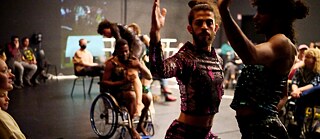Sulle Sponde Accessibility on stage

Forward Dance Company: Sulle sponde del lago – Am Ufer Des Sees | Photo (detail): © Tom Dachs
Sulle sponde, a dance piece premiering at the German Pavilion at this year’s Architecture Biennale in Venice, grapples with issues of inclusion and accessibility in the world of culture and the arts. We talked to the choreographer about it.
“Performing Architecture” is a series of events, exploring points of intersection between architecture and the performing arts. One highlight of the series is the upcoming 19 May premiere of Sulle sponde – On the Shore, a dance piece choreographed by Alessandro Schiattarella and performed by the Forward Dance Company of Lofft – das Theater in Leipzig. The Leipzig troupe are mixed-abled, i.e., a mix of physically normative and non-normative dancers.“Sulle sponde is a version of Sulle sponde del lago – On the Shore of the Lake that we developed last year between Basel and Leipzig,” explains the Naples-born choreographer. “It’s specially adapted to the interiors of the German Pavilion at the Venice Biennale.”
New aesthetics
This production is a critical take on the classic ballet Swan Lake that challenges traditional standards of physical beauty. “We take our cues from the entire history of Swan Lake, from traditional to contemporary versions of the ballet,” says Schiattarella. “We set about deconstructing them and reassembling them to reflect wider diversity, especially among the performers. We reinterpret movements, situations and aesthetics in ways never seen before in such an accessible form.”Schiattarella sees the Tchaikovsky ballet, which premiered in 1877, as a symbol of elitist ideals of beauty and ableism – i.e. discrimination against people with disabilities on the basis of their supposed inadequacy. “Just listening to the music of this iconic ballet makes you expect physical and technical perfection,” the choreographer explains. To him, taking on a classic like Swan Lake is a form of resistance against these ableist mindsets.
“It’s important to me to convey that there are different ways of thinking about dance, art and aesthetics, ways that can include very different bodies and experiences.”
Barriers in Venice
The Forward Dance Company of the Lofft Theatre in Leipzig is made up of six dancers – some with and some without disabilities – from five different countries. It’s the first permanent ensemble of its kind at an independent theatre in the German-speaking world.Bringing Sulle Sponde and the dancers to Venice was no mean feat. The problem wasn’t just the physical makeup of the city with its 120 islands, 350 bridges and its jumble of canals. The original plan was to perform the piece at the German Pavilion as well as at another local venue. But the troupe couldn’t find a single theatre in Venice that would provide barrier-free access to the stage for the dancers.
Not only that, but they had a hard time finding a barrier-free rehearsal room and hotel. Owing to its gravel paths, even the Giardini, the site of the German Pavilion, is not wheelchair-accessible. “It sure is astonishing that even an institution like the Biennale is not fully accessible. But that’s a reflection of our society,” Schiattarella remarks, “in which disability issues still come last.”
Structural problems
This city of myriad islands in a lagoon may seem particularly fraught with physical barriers, but it’s not the only one: “Just about wherever I go, I find myself faced with a lack of knowledge about structural problems like inaccessible architecture,” bemoans Schiattarella, who’s mostly active in Switzerland and Germany. “Even theatres accessible to spectators with disabilities are often inaccessible to performing artists with disabilities because there’s no means of access to the stage for them, no ramps, or lifts. That’s the way it is just about everywhere.”Alessandro Schiattarella emphasises that even major cultural and art institutions still don’t know what inclusion really means. “That’s another reason I think the work we do is important: to call attention to these shortcomings and heighten awareness of inclusion and accessibility issues at these institutions in future.”